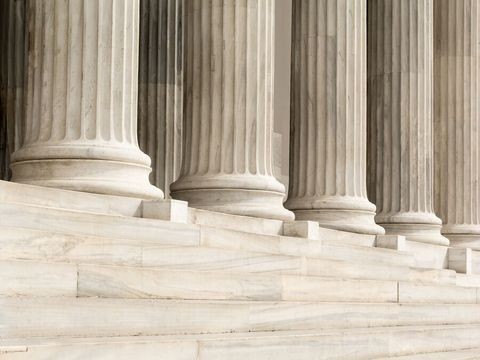Patent Law Alert: Supreme Court Has Opportunity to Bring Clarity to Patent Eligibility of Computer-Implemented Inventions
Client Alert | 4 min read | 12.11.13
With its decision to grant certiorari in Alice Corp. v. CLS Bank Intl., the Supreme Court has the chance to provide much-needed clarity to the proper framework for analyzing whether computer-implemented inventions are patent-eligible subject matter under 35 U.S.C. §101. Although the Federal Circuit in CLS Bank Intl. v. Alice Corp. Pty. Ltd., Appeal No. 2011-1301 (Fed. Cir. May 10, 2013) (en banc) affirmed the district court decision that the claims at issue were not directed to patent-eligible subject matter, a majority of the court failed to agree on a framework for analyzing patent eligibility. This has caused great uncertainty for inventors of computer-implemented inventions as to whether to seek patent protection as well as whether issued patent claims are valid and enforceable. Judge Moore of the Federal Circuit recognized this by candidly stating in her dissenting opinion that:
Our court is irreconcilably fractured over these system claims and there are many similar cases pending before our court and the district courts. It has been a very long time indeed since the Supreme Court has taken a case which contains patent-eligible claims. This case presents the opportunity for the Supreme Court to distinguish between claims that are and are not directed to patentable subject matter.1
Now that the Supreme Court has taken up this case, it is presented with the following question: "Whether claims to computer-implemented inventions – including claims to systems and machines, processes, and items of manufacture – are directed to patent-eligible subject matter within the meaning of 35 U.S.C. § 101 as interpreted by this Court?"2 We hope the Supreme Court takes advantage of the opportunity to answer this question and, importantly, provides a unifying framework for analyzing patent eligibility for computer-implemented inventions under 35 U.S.C. § 101.
As described in our Patent Law Alert of May 16, 2013, the Federal Circuit, in CLS Bank, affirmed the district court decision that the software-related claims at issue were not directed to eligible subject matter under 35 U.S.C. § 101 and issued five separate opinions presenting various conflicting frameworks for analyzing patent eligibility.3
In the five-member concurring decision of the court, Judge Lourie presented a three-step analytical framework for assessing patent eligibility. The first step is to decide if the claims fall within one of the four categories of patent-eligible subject matter specified in § 101—"process, machine, manufacture, or composition of matter."4 If step one is satisfied, the claims are evaluated in step two to determine whether they fall within one of the three judicially created exceptions to patent-eligibility—"laws of nature, natural phenomena, and abstract ideas."5 In this step, the abstract idea that may be at risk of preemption is identified. The third step is to evaluate the claim "to determine whether it contains additional substantive limitations that narrow, confine, or otherwise tie down the claim so that . . . it does not cover the full abstract idea itself."6
Judge Moore, in the lead dissenting opinion, criticized Judge Lourie's analysis for giving "staggering breadth to what is meant to be a narrow judicial exception" and ignoring the "mountain of precedent that requires us to evaluate each claim as a whole when analyzing validity."7
Chief Judge Rader also disagreed with Judge Lourie's analytical framework because it focuses on an abstract idea associated with the claim rather than assessing the claim as a whole. Chief Judge Rader offered an alternative analytical framework, which assesses whether the claim "includes meaningful limitations restricting it to an application, rather than merely an abstract idea."8 This framework involves analyzing the claim elements to determine whether each is inherent in the underlying abstract idea.
Judge Newman presented yet another analytical framework, which focuses on the categories enumerated in § 101. Under this framework, a claim directed to one of the statutory categories is deemed patent-eligible and "the laws of novelty, utility, prior art, obviousness, description, enablement, and specificity" are relied upon to eliminate abstract and unduly preemptive patent claims.9
In light of the splintered en banc decision in CLS Bank, the Supreme Court has a tremendous opportunity to clarify the law of patent eligibility under 35 U.S.C. § 101. We look forward to the Court's decision and, hopefully, a better framework for analyzing computer-implemented patent claims.
1 CLS Bank Intl. v. Alice Corp. Pty. Ltd., 717 F.3d 1269, 1314 (Fed. Cir. 2013).
2 Petition for Writ of Certiorari at (i) (citation omitted).
3 Mark Supko and Stephen W. Palan, Patent Law Alert: A Deeply Divided Federal Circuit Fails to Bring Clarity to Patent Eligibility of Software-Related Inventions in Closely Watched Case (May 16, 2013).
4 CLS, 717 F.3d at 1276.
5 Id. at 1277.
6 Id. at 1282.
7 Id. at 1313.
8 Id. at 1299.
9 Id. at 1322.
Contacts
Insights
Client Alert | 5 min read | 12.12.25
Eleventh Circuit Hears Argument on False Claims Act Qui Tam Constitutionality
On the morning of December 12, 2025, the Eleventh Circuit heard argument in United States ex rel. Zafirov v. Florida Medical Associates, LLC, et al., No. 24-13581 (11th Cir. 2025). This case concerns the constitutionality of the False Claims Act (FCA) qui tam provisions and a groundbreaking September 2024 opinion in which the United States District Court for the Middle District of Florida held that the FCA’s qui tam provisions were unconstitutional under Article II. See United States ex rel. Zafirov v. Fla. Med. Assocs., LLC, 751 F. Supp. 3d 1293 (M.D. Fla. 2024). That decision, penned by District Judge Kathryn Kimball Mizelle, was the first success story for a legal theory that has been gaining steam ever since Justices Thomas, Barrett, and Kavanaugh indicated they would be willing to consider arguments about the constitutionality of the qui tam provisions in U.S. ex rel. Polansky v. Exec. Health Res., 599 U.S. 419 (2023). In her opinion, Judge Mizelle held (1) qui tam relators are officers of the U.S. who must be appointed under the Appointments Clause; and (2) historical practice treating qui tam and similar relators as less than “officers” for constitutional purposes was not enough to save the qui tam provisions from the fundamental Article II infirmity the court identified. That ruling was appealed and, after full briefing, including by the government and a bevy of amici, the litigants stepped up to the plate this morning for oral argument.
Client Alert | 8 min read | 12.11.25
Director Squires Revamps the Workings of the U.S. Patent Office
Client Alert | 8 min read | 12.10.25
Creativity You Can Use: CJEU Clarifies Copyright for Applied Art
Client Alert | 4 min read | 12.10.25
Federal Court Strikes Down Interior Order Suspending Wind Energy Development



